An Introduction To Google Ads: How to Set Up a Google Search Campaign?
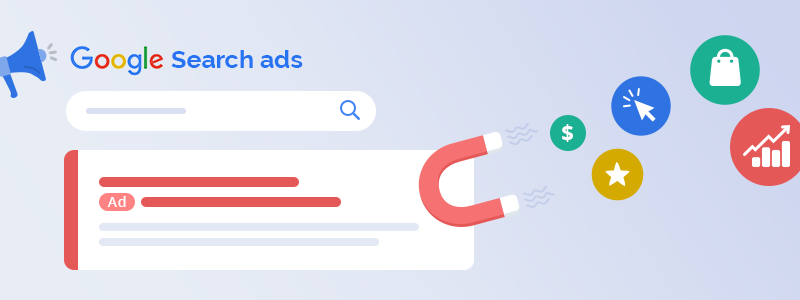
Today, we’ll talk about Google Ads - a platform that every nopCommerce store owner should leverage. More specifically, we’ll focus on Google Search ads - what they are, how they can benefit you, and how you can set up a successful Google Search campaign.
Overview
- What is Google Ads?
- What is the difference between a campaign, an ad group, and an ad in Google Ads?
- Why should you advertise on Google?
- What are Google Search ads?
- How can Google Search ads benefit you?
- How to set up a successful Google Search campaign in 5 steps?
- Inspiration and creative advice
- Wrap-up
What is Google Ads?
Google Ads is Google’s robust advertising platform. With Google Ads, you can run:
- Search campaigns - Text ads that appear on the SERPs (Search Engine Results Pages).
- Display campaigns - Remarketing ads that appear on websites that are part of the GDN (Google Display Network).
- Video campaigns - Video ads that appear on YouTube and other websites that are part of the GDN.
- Shopping campaigns - Product listings that appear in the Google Shopping tab. Some of these listings are paid, but you can also create free product listings.
- App campaigns - Ads that allow you to promote an app across multiple channels.
- Local campaigns - Ads that help you bring traffic to your brick-and-mortar store.
- Smart campaigns - An easy way to automate ad creation and improve the performance of your ads using Google’s machine learning capabilities.
Learn more about the different types of Google Ads campaigns → Choose the right campaign type
What is the difference between a campaign, an ad group, and an ad in Google Ads?
Once you create and set up your Google Ads account, you can start creating Google Ads campaigns - each campaign consists of different ad groups, and each ad group consists of different ads (the best practice is to create at least 3 ads per ad group) and keywords.
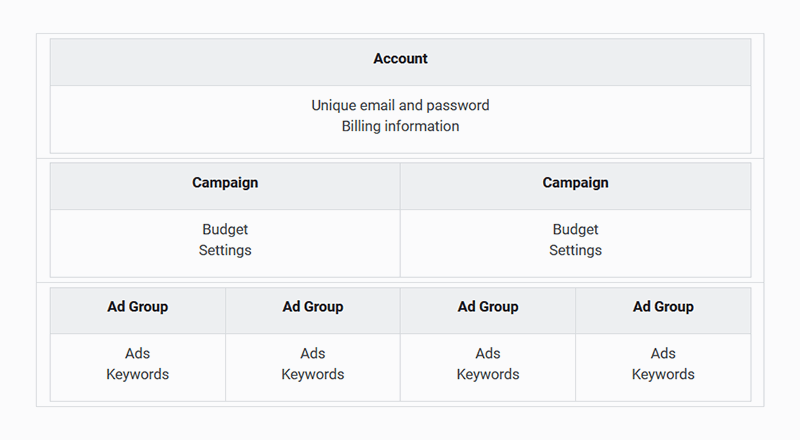
Source: Google, About your account organization
For example, you can have a campaign dedicated to each category in your nopCommerce store, and ad groups dedicated to your best-selling products. Then, you can create at least 3 different ads per ad group. In this way, you can run highly relevant ads that drive high-quality traffic to your nopCommerce store, i.e., targeted traffic that converts.
Why should you advertise on Google?
At any given moment someone somewhere is using Google to search for what your business offers. (Source: YouTube, Get Started with Google Ads)
Therefore, “Should I advertise on Google?” is a rhetorical question.
The benefits of advertising on Google are numerous - you can expand your brand reach, grow your business, generate leads, boost sales, and more. At the very least, advertising on Google will help you get more exposure on the SERPs, which is key to your e-commerce success.
“But doesn’t SEO take care of my exposure on the SERPs?”, you may ask. The answer is: “Yes.” But the more important question here is: “Is this exposure enough?”
To answer this question, we must dive deeper into the difference between SEO (Search Engine Optimization) and SEM (Search Engine Marketing).
What is the difference between SEM and SEO?
The SERPs consist of two types of listings - organic and paid.
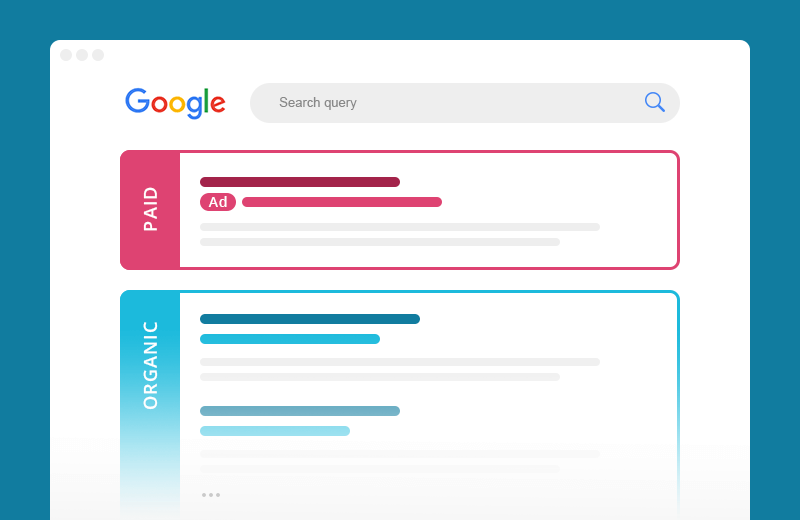
Each listing (whether it is organic, or paid) can bring traffic to your nopCommerce store.
SEO helps you get more organic (i.e., free) listings. The better your SEO strategy is, the more organic listings you’ll have on the first page of the SERPs. If your SEO strategy is exceptional, you can appear at the top of the SERPs, i.e., on the #1-#3 positions. If you get to the top of the SERPs, it is because Google rewarded you for creating unique, relevant, and high-quality content that deserves more exposure and clicks.
SEM describes the process of advertising on Google (and other search engines)*. Therefore, SEM listings (or ads) are paid listings, i.e., you pay every time someone clicks on your ad.
*Note: Since over 90% of internet searches are Google searches, we’ll focus solely on Google (Source: Review 42).
To sum up, if done well, both SEO and SEM can drive relevant traffic to your nopCommerce store. The only difference is that SEO drives free traffic to your website, and SEM drives paid traffic to your website.
Why should you combine SEM and SEO?
SEM and SEO are the two ways to get exposure on the SERPs. As a nopCommerce store owner, you already know that the more SERPs “real estate” you own, the higher your chances are to achieve your business and marketing goals - expand your reach, increase brand awareness, generate website traffic, boost sales, etc.
To maximize your exposure on the SERPs, you must combine SEO and SEM. In this way, your website can appear both in the organic results section, and in the paid listings section.
To sum up, both SEO and SEM are effective ways to get more exposure on the SERPs. But neither approach is as effective on its own as the combination of the two.
What are Google Search ads?
This is a Google Search ad:
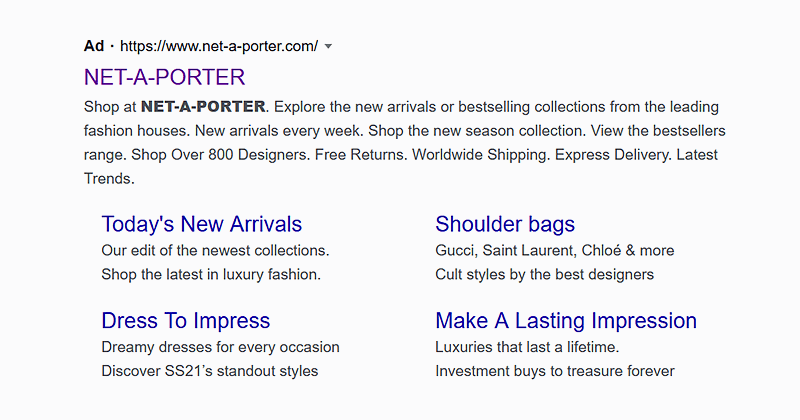
Google Search ads are text ads that appear on the SERPs - either at the top (above the organic listings) or at the bottom (below the organic listings). The position of your search ads depends on several factors - your bid and quality score are the two most important ones. Your bid is how much you’re willing to pay for a single click on your ad. Your quality score is based on your ads’ relevance, the landing page experience, and the expected CTR (click-through rate).
Google Search ads are triggered by keywords and always have an ad label (view the screenshot above). Remember that Google Search campaigns and Google Search ads are different things - a campaign is a collection of ad groups, and ad groups are collections of keywords and ads.
To create a successful Google Search campaign:
- Set clear and attainable goals. Define what would make your campaign a success - do you want to generate more sales, acquire new customers, build brand loyalty, etc.? Once you’ve defined your goals, create a strategy to achieve them. Come up with a plan, a timeline, and tasks for every member of your team.
- Define how you’ll measure the success of the campaign, i.e., which KPIs (Key Performance Indicators) you’ll measure. For example, will you measure success based on impressions, CTR, conversion rate, CPC (cost per conversion), the average position of your ad, quality score, etc.?
- Set a budget, you’re comfortable with. Your average daily budget is the amount you’re willing to spend on your ads on a given day. Your average monthly budget is your average daily budget multiplied by the average number of days in a month.
- Define your target audience. Your target audience consists of your existing and potential customers.
- Define your target keywords. Pro tip: You must target keywords that show buying intent. In this way, you’ll reach people who are more likely to buy your products, instead of people who are still in the consideration stage of their customer journey.
- Write engaging ad copy with enticing CTAs that incorporate your target keywords and resonate with your target audience.
- Optimize your landing pages. The overall quality of your landing pages is primary - remember that Google assesses the quality of your landing pages and the landing page experience to define where to display your ads on the SERPs. Also, a better page experience has proven to lead to more sales and a noticeable increase in customer satisfaction.
How can Google Search ads benefit you?
- You can expand your reach. Remember that Google’s search engine market share is more than 90%.
- Google Ads offers powerful targeting options. In this way, you can reach the right people at the right time and engage them with the perfect offer. As a result, you’ll drive high-quality traffic to your nopCommerce store. This will have a positive effect on your sales.
- Google Search ads help you achieve your business and marketing goals. For example, increase brand awareness, acquire new customers, boost conversions, build brand loyalty, etc.
- You can set yourself apart from your competitors (and even “steal” some of their traffic away).
- You have full control over your campaigns and budget.
- Running Google Search campaigns can get you to the #1 spot on the SERPs faster than optimizing your nopCommerce store for search. Of course, an integrated approach, i.e., a combination of SEO and SEM, will help you get even better results.
- If you set up Google Analytics you can gain powerful insights about your customers and their search patterns. Besides, the insights from your PPC campaigns can inform your SEO strategy and vice versa.
How to set up a successful Google Search campaign in 5 steps?
If you still don’t have a Google Ads account, set it up. Learn how → Google Ads sign-up guide
Before you set up your first Google Search campaign, you must set up conversion tracking.
To set up conversion tracking, open Google Ads > Tools & Settings > Measurement > Conversions.

You’ll see your CONVERSION ACTIONS and CONVERSION ACTION SETS.

In CONVERSION ACTIONS, you can see all your conversion actions, their source, category, tracking status (based on data from the last 7 days), how they’re counted, and more. Also, you can edit how long a conversion can be recorded after an ad interaction. For example, if your conversion window is 10 days and someone purchases the product from your ad on day 9 after the ad click, it is counted as a conversion, but if they place an order on day 11 or later, it isn’t.
CONVERSION ACTION SETS allow you to choose which conversions are shown in the “Conversions” column per campaign. In this way, you can focus on the conversions that matter most and optimize your bid strategies for them (if you use Smart Bidding).
Once you’ve set up conversion tracking, you can move on to setting up your campaign.
Step 1. Create a new campaign
- Click + NEW CAMPAIGN
- Select a campaign goal (e.g., Sales, Leads, Website traffic, Product and brand consideration, Brand awareness and reach, App promotion). Also, you can create a campaign without a goal > Click Continue.
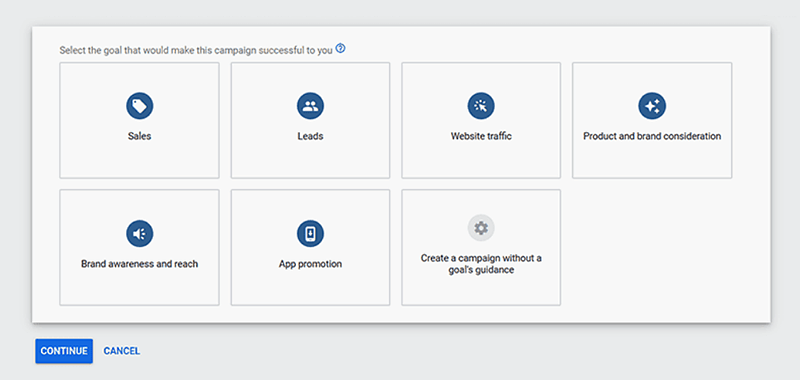
- Select a campaign type (e.g., Search, Display, Shopping, Video, Smart, and Discovery). Select Search > Click Continue.
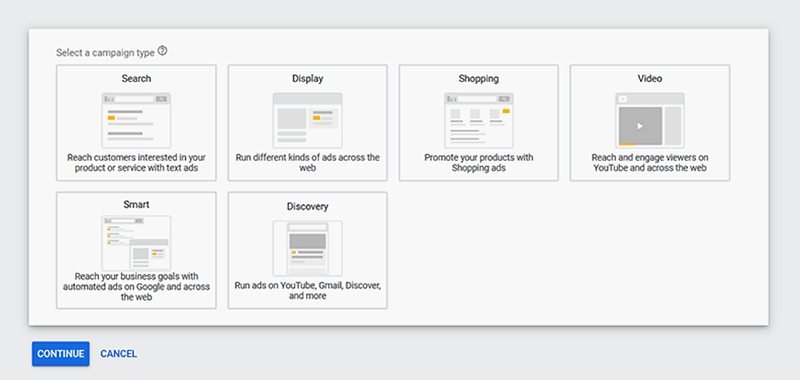
- Select the ways you want to achieve your goal.
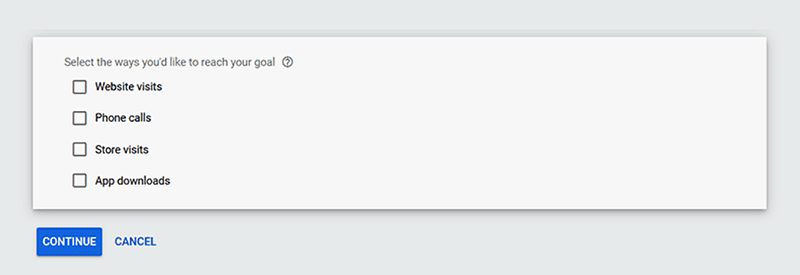
Step 2: Select campaign settings
General settings
- Fill in the name of your campaign in the “Campaign name” field.
- You have two options for networks: Search Network and Display Network. Mark “Search Network.”
- Click “Show more settings” to select start and end dates for your campaign, adjust the campaign URL options, and access Dynamic Search Ads settings.
Targeting and audiences
- Locations > Select locations to target. Select all countries you ship your products to - this will maximize your reach.
- Languages > Select the languages your customers speak.
- Audiences > Select audiences for your campaign. You can create audiences based on interests, habits, search behavior, interactions with your nopCommerce store (e.g., which pages the customer has visited), etc. In this way, you can tailor your ad copy to each audience and create more relevant and effective ads.
Budget and bidding
- Budget > Enter the average amount you’d like to spend daily. You can change your daily budget at any time. Note that you may exceed your daily budget on some days, but on others, you’ll spend much less. In this way, you won’t exceed your average monthly budget.
- Bidding > Choose your bid strategy (e.g., Conversions, Target CPA, Target ROAS, Maximize clicks, Maximize conversion value, Target impression share, Manual CPC, etc.).
- Click “Show more settings” to access conversions, ad schedule, and ad rotation.
Ad extensions
- Set up sitelink extensions, callout extensions, and call extensions for your ads.
- Add your own ad extensions.
Step 3: Set up ad groups
- Fill in the ad group name in the “Ad group name” field.
- Set a default bid.
- Add keywords. To find the right keywords, you need to consider several factors: keyword relevance, search volume, how competitive the keyword is, CPC (cost-per-click), and more. Also, you need to be mindful of keyword match types - parameters you set on the keywords you target.
Sidenote
Keyword match types give you more control over which queries trigger your ads. They can significantly impact your campaigns’ success. For example, using the different keyword match types right will give you more control over your budget and help you drive more targeted traffic to your nopCommerce store, maximize conversions, remove friction, and more.
There are three different keyword match types for Google Search ads: broad match, phrase match, and exact match.
Broad match: The default keyword match type
Broad match is the least restrictive keyword match type and gives you the least amount of control over which queries trigger your ads.
Broad match keywords aren’t accompanied by special symbols. For example, if the main keyword is men’s shoes, it would be displayed simply as men’s shoes. If men’s shoes is a broad match keyword, your ads may appear for a large number of queries - synonyms, close variations, related searches, and other relevant keywords (the broad match keyword doesn’t even have to be in the search query). For example, gentlemen boots, footwear for men, men’s oxford shoes, etc.
Depending on the volume of the keyword, broad match keywords allow you to reach many people. In fact, they allow you to reach the widest audience possible. Which means they’ll drive a ton of traffic to your nopCommerce store. However, because some of the keywords that will trigger your ads won’t be so relevant, this traffic won’t be very targeted - most visitors will be random users who viewed your ad but might not need your product at all. A solution to this issue is to create a negative keywords list and add it to your campaign. In this way, your ads will be triggered only by relevant queries. Learn more about broad match
Phrase match: The golden mean between broad match keywords and exact match keywords
Phrase match gives you both control and flexibility. You’ll know a keyword is a phrase match if it is in quotation marks (“”). For example, if women’s boots is a phrase match keyword, it will look like this - “women’s boots”.
Phrase match tells Google that the ads can be triggered by queries that contain matches of the phrase (or close variations of it). Additional words can appear before or after the phrase, but never in between.
For example, if women’s boots is a phrase match keyword, the ads can appear for queries like faux leather/suede/beige/grey/etc. women’s boots, buy women’s boots, women’s boots sale, grey suede women’s boots sale, and more. Learn more about phrase match
Exact match: The most restrictive keyword match type that gives you the highest level of control over the queries that trigger your ads
Exact match keywords are in brackets ([]). For example, if women’s boots is an exact match keyword, it will look like this - [women’s boots].
If a keyword is an exact match, Google knows that it should display your ads for exact matches of the term (e.g., women’s boots for [women’s boots]), or close variations of the term with the same meaning. Such variations include synonyms, plurals, or other variations of the keyword (e.g., boots for women, boots women, etc.).
Ultimately, exact match keywords drive less traffic to your nopCommerce store. However, because the queries that trigger your ads are extremely relevant, this traffic will be extremely targeted as well, i.e. it will be high-quality traffic that converts. Learn more about exact match
Step 4: Create ads
To create a new text ad:
- Add the landing page URL in the “Final URL” field.
- Write the Headlines (30 characters per headline). Make them enticing.
- Write the Descriptions (90 characters per description). Ensure they’re accurate, informative, and engaging. Include relevant CTAs and try to create a sense of urgency using phrases like “Order Now!” “Place An Order Today!” “Buy Now!” “Limited-Time Offer!”, etc.
- Edit the Display path.
- Select Ad URL options.
- Click Done.
Remember that the best practice is to have at least 3 ads per ad group - this maximizes your chances for conversions and allows you to provide a more personalized customer experience. Note that the ads in each ad group should be unique - each ad should add value, convey a different message, highlight a different USP (unique selling point), or even cater to a different audience.
Step 5: Confirmation
Congratulations on successfully setting up your first Google Search campaign. In the last step of the setup process, you can review your campaign summary (start and end date, locations, languages, budget, goal, bid strategy, ad groups, keywords, etc.) and view daily estimates for clicks and cost.
Inspiration and creative advice
A Google Search ad consists of:
- Three headlines (30 characters each)
- Two descriptions (90 characters each)
- Two paths (15 characters each)
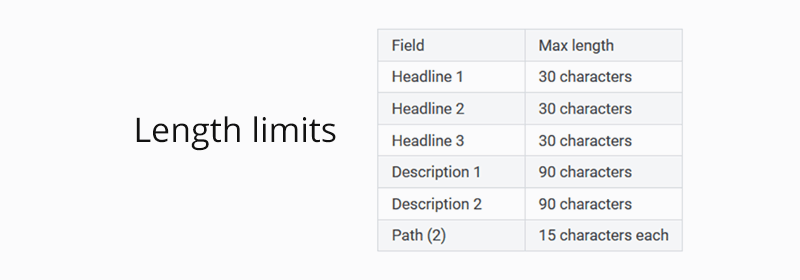
Source: About text ads
Engaging ad copy is paramount to the success of your search campaigns. In this section, we’ll share some tips on making the most of the 270 characters you’ve been given (in terms of copy, you care about the headlines and the descriptions).
There are several “rules” you must follow:
- Simplicity is key
- Impeccable grammar is paramount
- Leverage incentives to drive clicks and engagement
Let’s elaborate! Your main goal is to say more with fewer words. So, choose them carefully. Get in your customers’ shoes. For example, if you sell sports gear, ask yourself “What would make me click on an ad for snowboard boots / climbing shoes / running shorts / athleisure / bike / protein bars / etc.?” This will help you define what type of information to include in your ad copy. Then, you need to figure out how to convey your message in an enticing, yet, non-intrusive manner.
But let’s be more specific. Here are some of the best practices for creating effective ad copy for your Search campaigns!
Write powerful headlines.
For example, if you sell apparel, use phrases like “Iconic Pieces.” Elevate the headline by highlighting key benefits in the description (“Fast Delivery & Free Returns!” and “Fast Delivery Worldwide.”).

Another way to approach your headline creation, is to use a CTA, such as “Update Your Wardrobe Today” - a less intrusive alternative to “Buy Now!” “Order Today!” etc.

Of course, you can never go wrong with the classics - “On Sale Now,” “30% Off Beach Accessories,” “Free Shipping,” “Easy Returns,” “International Shipping,” “Fast Delivery,” “Money-Back Guarantee,” etc.
Your headlines must complement each other.
For example, “Best Rhubarb Protein Bars | 30% Off - Offer Ends Tomorrow! | Free Shipping! Buy Now!” is better than “Best Rhubarb Protein Bars | Quality Protein Bars On Sale | Buy Protein Bars Now!”
Optimize your headlines for your target keywords.
Don’t include your target keywords in all headlines - this will make your ads look spammy. Instead, include your target keywords in the first headline, and use the second and third headlines to highlight a benefit. For example, “Personalized Jewelry” (H1), “30% Off + Free Customization” (H2).

Use your descriptions to enhance your headlines and tell your customers why they should buy your products.
Again, you can highlight a benefit (e.g., “Always Handmade”), a USP (e.g., “Fair Trade”), or say what makes your brand special (e.g., “Shop fair trade jewelry and support global artisans to continue their craft”).

Depending on your business and target audience, you can talk about your environmental impact. You can mention that you use 100% recycled materials, that you plant a tree for every $1 spent on your website, that you donate money to a non-profit organization, that you offer climate conscious delivery, etc.

Notice how in this example, the headline focuses on Patagonia’s environmental footprint (“Climate Conscious Delivery”) and the description highlights other benefits (“Fast Shipping,” “Free Returns With Pick-Up,” and “Safe Delivery”).
Also, note that phrases like “Free And Easy Returns”, “Money-back Guarantee”,”“X Years Warranty”, “Safe Delivery,” “Curbside Pickup” etc. boost your credibility. So, if you offer them, don’t forget to mention it!
Use promotions to catch your customers’ attention (e.g., “50% Off,” “Extra 10% On Discounted Items,” “20% Off Summer Essentials,” etc.).
You can even include a discount code and an end date - this will create a sense of urgency which will increase CTR.
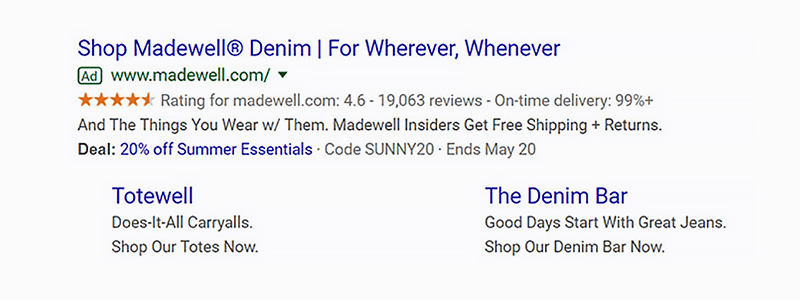
Use numbers - this will boost your credibility and make potential customers feel more confident about buying from you.
For example, use phrases like “Buy Now For $89.99,” “Over 95% Customer Satisfaction,” “Trusted By 15,589 Customers,” “20,000+ Orders Shipped,” “Kids Sweaters Starting at $2.79,” etc. The more specific you are, the better!
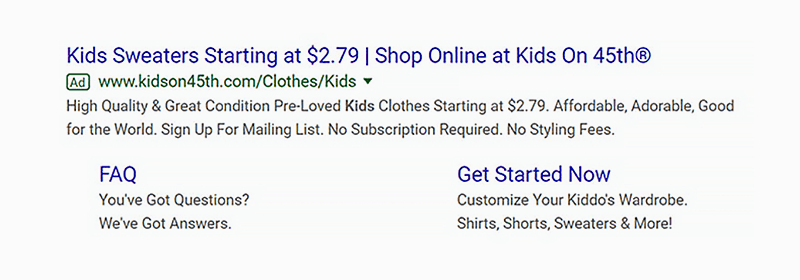
Write enticing, clear, and benefit-oriented CTAs.
For example, “Buy Today And Get $30 Off Your Next Order!” or “Order Now And Get An Extra 10% Discount! Offer Ends Today!”
If you have a brick-and-mortar store, include location and business hours to catch the attention of local customers and drive more traffic to your store.

To sum up, there are many ways to approach ad copy creation. To find what works best for you, test different ads and see which message resonates best with your target audience. Get inspired → 50 Google Ads examples (and why they work)
Wrap-up
Advertising on Google may seem daunting at first, but, once you understand how the platform works, campaign setup becomes a breeze! Also, it is an effective way to expand your reach, tap into new markets, grow your business, raise brand awareness, drive sales, and more. So, you should absolutely consider it!
We hope this guide will help you understand how Google Ads works and how it can benefit you. Also, we hope it will give you the confidence and the expertise to set up your first Google Search campaign. If you have further questions, just leave a comment below! And stay tuned for our next Google Ads article in which we will focus on Google Display ads.




